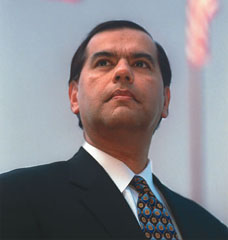
Los Angeles Times says: Gaddi H. Vasquez stepped down as Orange County supervisor in 1995, 15 months early, before the grand jury took action on his colleagues. He became a Southern California Edison executive and eventually resurrected his political career by being confirmed in January 2002 to head the Peace Corps; he recently left that post.
O.C. Rebounds, Frayed at the Edges
Ten years after the bankruptcy, county is said to be run well. But emergency 'is coming,' road chief warns.
By Mike Anton
Times Staff Writer
December 5, 2004
When risky investments caused more than $1.6 billion to evaporate and forced Orange County to declare bankruptcy in 1994 — the nation's largest municipal default — some predicted Armageddon.
One national business writer described a "mushroom-shaped cloud that hangs over Orange County." Some said county government would come to a standstill, that the 200-plus school districts, cities and public agencies with stakes in its mismanaged investment pool would be crippled for a decade or more. Others warned that bankruptcy would lead to more crime, more drunks on the streets — even an outbreak of tuberculosis.
"It is now only a matter of time before children start dying," one social worker pleaded to supervisors who were forced to slash the county budget.
But as the 10th anniversary of the default arrives Monday, the bankruptcy appears at first glance to be little more than a pothole in the rearview mirror. Those who lost money have largely been repaid. The county's creditworthiness — which plunged to junk-bond status — is higher than ever. And tuberculosis rates are down.
However, the effects linger in many subtle yet significant ways.
The county still owes about $810 million of the more than $1 billion it borrowed to reimburse creditors. That debt, scheduled to last until 2026, costs the county $90 million a year — money that otherwise could go to parks, healthcare, social services and roads.
Cutbacks mean less landscaping and more brown grass at county parks. Can't afford mental health counseling? Chances are you'll have to wait. Landfills are filling up more quickly because Orange County takes in trash from Los Angeles and San Diego counties to raise debt repayment money.
Streets are rougher because the county defers road repairs to help retire the debt. Before bankruptcy, county roads were resurfaced every five years. Now it's every seven.
Carpets in county buildings are dirtier — and thus wearing out faster — because of the debt. Cutbacks made in routine cleaning and maintenance of county facilities remain in place a decade after the bankruptcy.
Double Duty
"People have to do double duty on a lot of jobs," said Bob Wilson, director of internal services for the county's resources and development management department. "Overall, the conditions of the county's buildings are less than they were before the bankruptcy because of deferred maintenance, even though we know it costs you more in the long run."
When a toilet valve went out one weekend at the Harbor Justice Center, for example, the ensuing flood caused $300,000 in damage. "If we had regular preventive maintenance, that valve would've been replaced," Wilson said. Cost: $10.
The roots of the bankruptcy reach back to the passage of Proposition 13 in 1978. In its wake, the Legislature froze each county's share of property taxes. Orange County — at the time less populated, politically conservative and tight-fisted — spent the least per capita on government services covered by property taxes. Because that rate was frozen, the county to this day receives just 6 cents for every $1 of local property tax paid — the lowest rate in California. Robert L. Citron, the county's longtime treasurer, devised an aggressive — and widely admired at the time — investment strategy to make up the difference: He borrowed money to place big bets on speculative high-yield securities that depended on interest rates remaining low.
When rates rose, $1.64 billion in public money vanished.
Citron lost his job and went to jail after pleading guilty to felony fraud charges. And the county, which later recovered hundreds of millions of dollars by suing its Wall Street advisors, had to find ways to not only live with that reimbursement formula and later state budget cuts, but also repay the bankruptcy debt.
Orange County ranks No. 1 among California counties in debt service per capita — but near the bottom in spending per capita, according to an analysis by the California Institute for County Government, a nonpartisan public policy research group.
"I wouldn't ever say bankruptcy was good for the county. But, ironically, Orange County is a very well-run county now," said institute director Matthew Newman. "Bankruptcy has had a lot to do with that. It got people to focus on what's important and run as tight of a ship as they could."
Painful Cuts
That tight ship has come at the expense of myriad cuts in services.
The county's $543-million discretionary budget is less than it was before the bankruptcy, when factoring in inflation. Its work force, with nearly 2,000 jobs cut after the bankruptcy, has bounced back to 17,546 positions, nearly 2% more than in 1994; but during the same period, the population increased 16%.
The tentacles of bankruptcy reach into nearly every corner of government.
The county has, at times, had trouble competing for top managerial talent. Even renovating a government building requires more work than normally needed: Because all county property is pledged as bond collateral and leased back, with the rent going to debt repayment, the county requires permission from the bond's insurer before altering that property.
The debt repayment plan siphons money from four county departments every year, affecting projects big and small. The four departments — overseeing redevelopment, trash collection, transportation and parks — were singled out because their budgets contained discretionary spending that could be cut.
About $4 million is diverted each year from the Orange County Development Agency, leaving less money for neighborhood projects such as new sidewalks and storm drains.
The Integrated Waste Management Department turns over to the debt about $15 million a year it earns accepting upward of 1 million tons of trash from other counties.
A complicated revenue-swapping deal with the Orange County Transportation Authority — which required legislative approval — will ultimately cost the county $170 million in road funds. The loss has meant delaying such projects as the widening of Laguna Canyon Road, now underway after years on the back burner.
Windfalls of state money in 2000 and 2001 allowed the county to catch up on nearly $13 million worth of backlogged street repairs. Without another such cash injection, roads will deteriorate badly within a decade, officials predict.
"The emergency is not here," said Bill Tidwell, in charge of the county's road maintenance. "But it's coming."
Departments Pitch In
Finally, the Harbors, Beaches and Parks Division contributed about $7 million this year to help pay off the debt. The amount grows each year, and by 2016 nearly $148 million that could have gone into maintaining and enlarging the parks system will have instead gone to creditors.
Like county buildings with millions of dollars in deferred maintenance, the effect bankruptcy has had on Orange County's 38,000 acres of wilderness, parks and beaches isn't immediately noticeable. But it's there: dry rot in buildings, rusty bathroom fixtures, weathered roofs and deteriorating rock walls.
"Does the public draw a distinct line from the bankruptcy to conditions in the parks? I doubt it," said parks director Kevin Thomas. "Progressively, over time, the impacts will become greater and greater."
For years, there's been a call for a new regional park in populous north county. But that's not likely to happen until after 2016, when siphoning of the parks' budget stops.
"Even if the land was donated to us, it would take [millions of dollars] for the water, sewer and electrical systems just to make it into a place of green grass," Thomas said.
Acknowledging the hit to the park system, supervisors last week restored $5 million to its budget, thanks to an expected surplus of state funds. The money will go toward refurbishing the sewage system at O'Neill Regional Park.
The county's Health Care Agency, while its budget doesn't directly contribute to debt repayment, also endured deep cuts after the bankruptcy. "The services that were lost were never replaced," said agency director Julie Poulson.
Mental health programs were hit hard. Inpatient hospital beds were eliminated, outpatient programs cut and a counseling clinic closed. Public health programs were also cut, including education targeting needy women and children and nursing visits to the homes of sick infants.
In the last two years, state budget cuts forced $27 million in additional Health Care Agency reductions. More treatment beds for the mentally ill were axed, as were a mental health clinic for children and six public health clinics.
Orange County, its hands tied with bankruptcy debt, didn't have the option of increasing its share of health spending to make up for the state cuts, said Thomas Beckett, the county's public finance manager.
"Social services and healthcare are trained to know they're not going to get anything more out of the general fund," Beckett said. "It's always going to be tough."
Last month's passage of Proposition 63, which will tax the wealthy to expand public mental health programs statewide, is expected to provide the county with a windfall. But it won't make up for the deep cuts since the bankruptcy, said Mary-Evelyn Bryden, who serves on the boards of state and county mental health advocacy groups.
"We're starting from so far back, even though [Proposition 63 money] will fill a lot of gaps, it won't fill enough of them," she said. "It will take years for us to catch up."
Times staff writer Jean O. Pasco contributed to this report.
*
(BEGIN TEXT OF INFOBOX)
Key figures in Orange County's bankruptcy -- then and now
Orange County government was thrown into turmoil after it declared bankruptcy Dec. 6, 1994. Many elected and appointed leaders quit or were fired, and several were prosecuted.
Robert L. Citron
Orange County's disgraced treasurer pleaded guilty to six felony counts of fraud and misappropriation of funds. He was sentenced to a year in jail but, in frail health, instead spent eight months working in commissary. He remained on probation until 2002. He and his wife live in Santa Ana.
Matthew R. Raabe
The county's assistant treasurer also was convicted of fraud and misappropriation and served 41 days in jail before the verdict was overturned. Taxpayers spent $1 million on his defense. He has since moved to Northern California.
Ernie Schneider
Schneider, who earned $140,000 a year as county administrator, was fired soon after the bankruptcy, blamed for failing to exercise proper oversight of the treasurer. He went to work as a consultant to developers and now is a real estate executive.
Ronald S. Rubino
The county's budget director was tried on fraud and misappropriation charges, but a jury deadlocked in favor of acquittal. He pleaded no contest to one record-keeping violation under a deal that allowed his record to be erased after a year. He went on to co-found a software company based in Santa Ana.
Steve E. Lewis
The auditor-controller warned that Citron was making "risky and unusual transactions" to boost the interest earnings on investments. But his warnings were soft-pedaled in unread reports, and critics said he never followed up. He was charged with civil misconduct in office, but the charges were dropped. He left county service in 1998.
O.C. supervisors
Roger R. Stanton and William G. Steiner were indicted by a grand jury on grounds of failing to safeguard public funds. The indictment was later dismissed by an appeals court ruling that said failing to do their jobs wasn't a crime. Stanton retired in 1996, and six years later he unsuccessfully sought a seat on the Fountain Valley City Council. He now teaches government at Cal State Long Beach. Steiner retired in 1998, moved to Arizona to work for a child advocacy group and later returned to Orange County as a principal in the government consulting firm Hebrock & Steiner. Gaddi H. Vasquez stepped down as supervisor in 1995, 15 months early, before the grand jury took action on his colleagues. He became a Southern California Edison executive and eventually resurrected his political career by being confirmed in January 2002 to head the Peace Corps; he recently left that post. Thomas F. Riley retired as a supervisor a month after the bankruptcy and died in 1998. Harriett M. Wieder also retired at the end of her supervisorial term in 1994 and is a government consultant.
Sources: Jean O. Pasco, Times staff writer; photos from Los Angeles Times
Los Angeles Times







